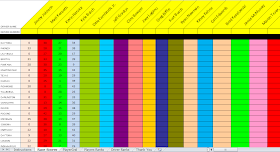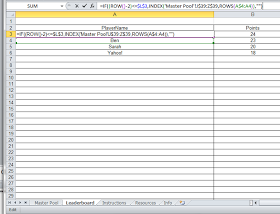A reader recently asked me for help with creating a NASCAR Fantasy League spreadsheet and I’m making a template of it available for download. I’ve created Excel templates for many other games and sports, including one for horseshoes, but this is our first NASCAR spreadsheet! This NASCAR fantasy game is based on Total Driver Points according to NASCAR’S scoring system. In order for your drivers to score they must be running for Sprint Cup Points. Drivers may run in more than one NASCAR division but can only score points in one division.
Here's how to play: At the beginning of the year (first race is Daytona on February 23rd) participants choose ten race car drivers. These will be their 10 drivers for the entire year - no changing after the entry deadline. All players also submit the three drivers that they think will place 1st, 2nd, and 3rd in the NASCAR standings at the end of the year. They don’t need to have these drivers in their picks, just who they think is going to finish on top. This is used as a tie-breaker.
The fantasy league manager manually enters each player’s picks into the spreadsheet once at the beginning of the year. They keep the same drivers all year long. After each race, the manager then goes to ESPN.com and enters the amount of points that each driver earned during the race into that driver’s column. The spreadsheet then automatically adds and ranks each player according to their driver’s scores. I used many of the same formulas found in the leaderboard of my NCAA Bowl Prediction Pool sheet. Can currently handle up to one hundred drivers and one hundred participants without needing to modify a single formula.
You can make each player pay a fee to play the game and split the pot to the top three winners. (1st=70%, 2nd=20%, 3rd=10%) Or many people have told me they like to use these types of games to raise money for charities, which is awesome!
To download the 2014 NASCAR Fantasy League manager simply click the link below which will take you to the box.com, where the file is hosted. Next, click on the “Download” link in the upper right hand corner. That’s it!
If many readers play NASCAR fantasy games and find this useful I will improve the spreadsheet by automating the entry process and come up with a way to update the driver scores easier. This is the first version of the template and I don’t follow NASCAR myself so I’m sure it can be improved in some areas. Please let me know if you have any suggestions!
 |
| The sheet to track the scores for each race and driver respectively. |
Here's how to play: At the beginning of the year (first race is Daytona on February 23rd) participants choose ten race car drivers. These will be their 10 drivers for the entire year - no changing after the entry deadline. All players also submit the three drivers that they think will place 1st, 2nd, and 3rd in the NASCAR standings at the end of the year. They don’t need to have these drivers in their picks, just who they think is going to finish on top. This is used as a tie-breaker.
 |
| Player ranking sheet. |
The fantasy league manager manually enters each player’s picks into the spreadsheet once at the beginning of the year. They keep the same drivers all year long. After each race, the manager then goes to ESPN.com and enters the amount of points that each driver earned during the race into that driver’s column. The spreadsheet then automatically adds and ranks each player according to their driver’s scores. I used many of the same formulas found in the leaderboard of my NCAA Bowl Prediction Pool sheet. Can currently handle up to one hundred drivers and one hundred participants without needing to modify a single formula.
You can make each player pay a fee to play the game and split the pot to the top three winners. (1st=70%, 2nd=20%, 3rd=10%) Or many people have told me they like to use these types of games to raise money for charities, which is awesome!
To download the 2014 NASCAR Fantasy League manager simply click the link below which will take you to the box.com, where the file is hosted. Next, click on the “Download” link in the upper right hand corner. That’s it!
If many readers play NASCAR fantasy games and find this useful I will improve the spreadsheet by automating the entry process and come up with a way to update the driver scores easier. This is the first version of the template and I don’t follow NASCAR myself so I’m sure it can be improved in some areas. Please let me know if you have any suggestions!





